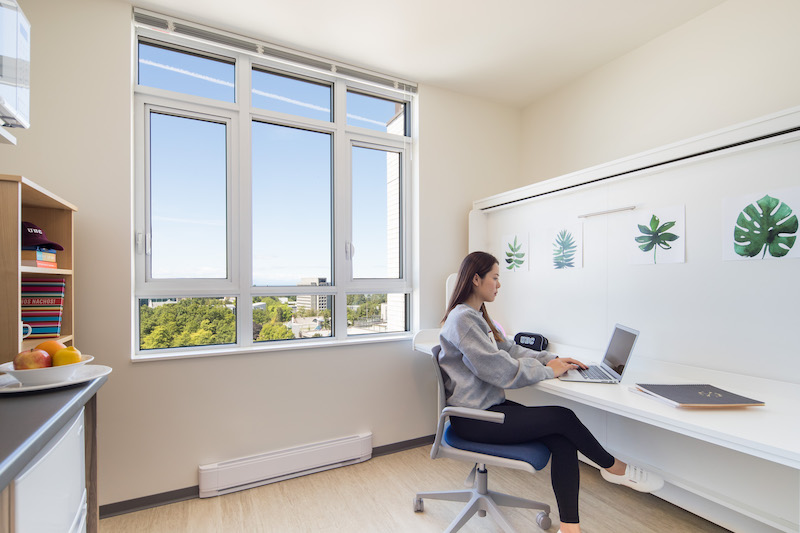Welcome back to part four of the Student Life Series where we discuss strategies for student housing in the COVID-19 era. COVID-19 has already had a dramatic impact on higher education, and only time will tell the continued impacts as colleges and universities prepare for the next school year. What we do know is that student housing will be one of the greatest areas of concern, since this is naturally the area where students have significant, personal contact with one another. At the same time, student housing remains a vital part of the student and campus experience. So we need strategies that protect students, preserve the role of the residence hall, and make sense for the university over the short and long terms.
Recent data about the spread of COVID-19 identifies face-to-face interactions (and respiratory droplet transfer) as the primary means of transmission. This same research shows that the virus does not live long on common surfaces. This leaves student housing professionals and designers to focus on reducing face-to-face interactions and droplet transfer while preserving the residence hall’s vital role in recruitment, social engagement, campus community, and ultimately, student success.
Let’s start with some context. While some institutions may focus on turning double occupancy residential units into single occupancy (creating an optimum social distance), we have to consider the implications of this strategy. Will it increase rental rates while decreasing the university’s available housing capacity (and revenue)? Will it negatively impact first and second year experiences, in which double occupancy rooms are a prime component of the housing experience that is proven to aid in student success? With the growing concerns around higher education’s cost of attendance, student housing and food insecurity, and student debt, we need to be careful about preserving affordability. Alongside these considerations, we have to acknowledge the possibility that many residence halls may be partially or completely empty as some institutions choose to only offer classes online and students opt to stay home. Might this be an opportunity for selective or tactical renovations to address COVID-19 type measures as well as needed facility upgrades? And finally, whatever student housing adaptations we make today, can they also serve as resiliency measures for unforeseen viruses and circumstances of the future?
THE FAMILY UNIT
There is a fairly immediate and inherent challenge with student housing in the COVID-19 era: students living in very close proximity to one another. Short of converting double occupancy to single occupancy units (which some institutions are pursuing), many colleges and universities are suggesting that roommates in shared residential units treat each other like immediate family members, a.k.a. The Family Unit. Outside the unit, they wear a mask and take all necessary precautions. Inside the unit, they can be mask-free and limit their direct exposure to only those peers.
As personal protective equipment (PPE) becomes commonplace, we are hearing interest in “PPE stations”, areas where masks, sanitizer, gloves, and wipes are consolidated for disposal, cleaning, and resupply. These installations may soon be accompanied by “testing stations”, areas where a clean mouth swab can be retrieved and a test sample deposited as institutions attempt to monitor on-campus infection both proactively and discreetly. We have even heard of some businesses incorporating infrared temperature readings at turnstiles or touchless thermometers. While this may seem extreme, it could be the next step in virus detection and prevention at the scale of a residence hall.
SOCIAL DISTANCING FOR THE RESIDENCE ROOM
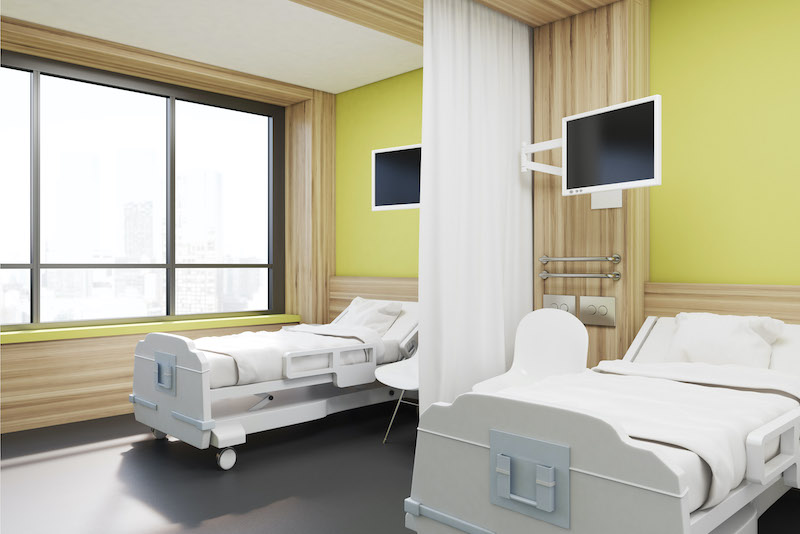 Hospital curtains can be reinterpreted as a flexible way to provide virus protection and individual privacy.
Hospital curtains can be reinterpreted as a flexible way to provide virus protection and individual privacy.
Student housing at many institutions has included a number of design features that could once again prove valuable in the COVID-19 era. Partial or ‘pony’ walls along with strategically placed furniture (like armoires) have been used to create privacy between roommates in the past, and now, these same strategies could provide an important room zoning function. At a recent project, where the design team was asked to adapt a former hospital into a student residence, focus groups noted that the ceiling-mounted curtains wrapping around beds could be saved or reinterpreted as a simple, cost effective, and flexible way to provide individual privacy. In today’s context, this privacy barrier also provides virus protection. We could design these curtains in a more attractive fashion, with color, pattern, and perhaps a clear plastic section for visual connectivity. Now, we have a feature that is protective in the short term and provides privacy and residential character in the long term.
In new construction projects, adding a small sink to a bedroom can allow for a notable decrease in the need for surface cleaning as teeth brushing and more frequent hand washing (another protective measure) are able to be done without leaving the room. Other benefits of a sink in the bedroom include limiting the exposure to community bathrooms and the separation of bathroom fixtures that often allows for greater use among roommates. As yet another benefit, a sink in the bedroom may be particularly attractive to students with religious beliefs that require additional washing, allowing them to more easily and privately do so. Something as simple as the installation of a hand sanitizer dispenser at the room entry door could be another cost-effective solution that we see in hospital and healthcare design.
DON’T LEAVE OUT THE COMMON SPACES
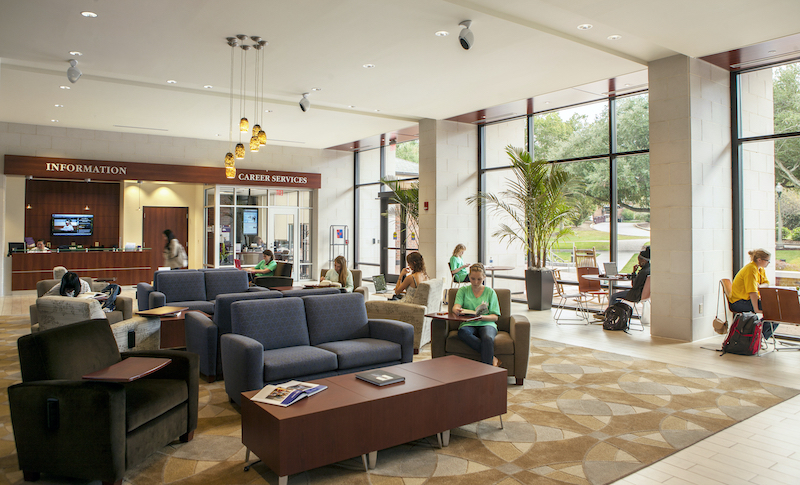 Socially separated common space.
Socially separated common space.
In the COVID-19 era, we would urge colleges and universities to re-design rather than eliminate residence hall common spaces. We know that these gathering areas promote student success in ways that are core to higher education’s mission and are among the most valued features by students. The rethinking of these spaces could include thoughtfully executed social distancing signage and cues that can be adjusted depending on the current circumstances. Think of a six-foot reference today that could be adjusted to more or less tomorrow. We have seen the separation of large spaces into smaller group settings with strategically placed white boards, TV monitors, and furniture arrangements. The furniture itself may adjust with high partitions that give an added layer of virus protection, social separation, and acoustic privacy.
We may even see common spaces used very strategically for distance learning. As universities look to de-densify classrooms, they could set up a residence hall lounge or living room as a remote classroom with live feeds and video chat capabilities. Common spaces could even be used to address the dramatically increasing health concerns (due to COVID-19) and psychiatric counselling demands (pre-existing) on campus by converting small spaces into ‘telemedicine’ chat rooms. As suggested here, the opportunity to pivot common spaces toward flexible, long-term value for students and the institution is significant.
TOUCHLESS ENVIRONMENTS
Even though we are finding that COVID-19 spreads more frequently through face-to-face contact, we know that reducing water droplets through touchless environments can help reduce transmission. Keycard touchpads, automatic front door openers, and elevator card swipes are obvious place to begin (with many of these strategies already in place). Many schools have had interest in keyless, card swipe, or tap room doors but, have been deterred by the cost of installation. Perhaps the cost of installation will come down with a resurgent demand, or institutions will simply view this as a good time to invest. ‘Self-cleaning’ door handle sleeves may be another option here.
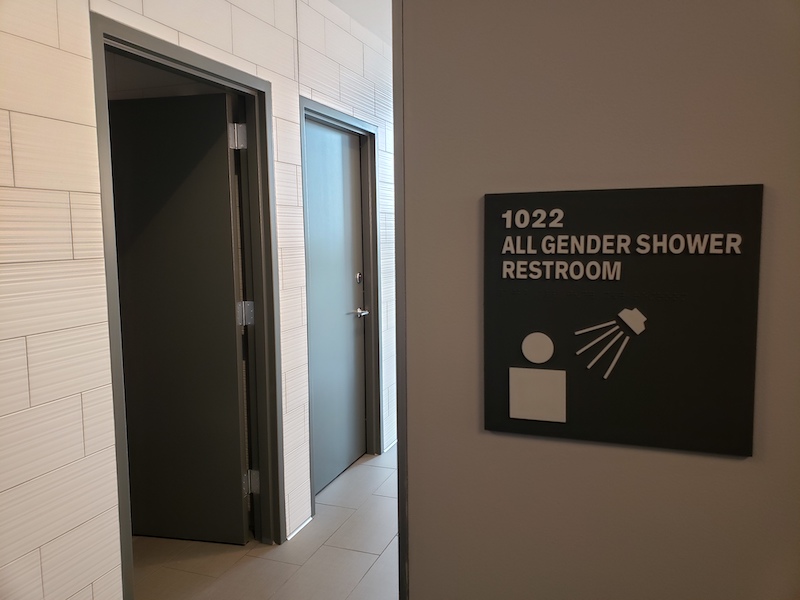 Doorless community bathroom.
Doorless community bathroom.
Bathrooms are the next obvious area for touchless advances. We are all familiar with touchless bathroom fixtures like sinks, toilets, urinals, and hand dryers. But, we may see touchless bathroom entry doors, or the removal of the door altogether, which can be designed to provide privacy, universal access, and gender-neutral options. At the scale of the individual room, we will continue to see the prioritization of occupancy sensors and voice commands tied to lighting and mechanical systems, eliminating these high touch points while helping with energy conservation.
THE AIR WE BREATHE
Another opportunity to safeguard the residence hall environment against the spread of COVID-19 is improving the indoor air quality. One way to do this is to look at mechanical engineering standards typically applied to healthcare environments. These strategies may include increasing the amount of outside air versus recirculating air, upgrading to high-efficiency particulate air (HEPA) filters, creating higher rates of air change that circulate through a given room, and even implementing positive / negative air pressure adjustments that can influence the path of travel of airborne particulates. Residents can even increase the outdoor air supply and natural ventilation of a room with carefully designed window openings, personal fans, and technology that switches off the HVAC system when a window is open. This feature has the long-term benefit of improving energy performance and tracking room occupancy as an added layer of building security.
SINGLE OCCUPANCY AND AFFORDABILITY
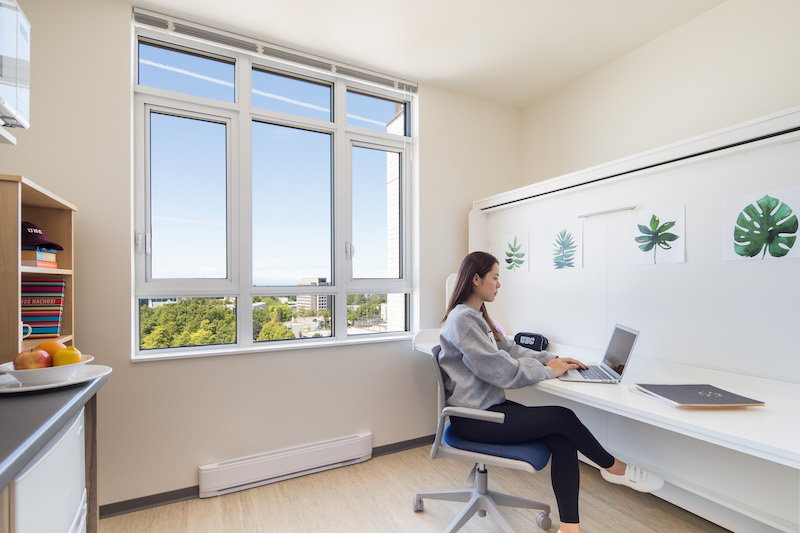
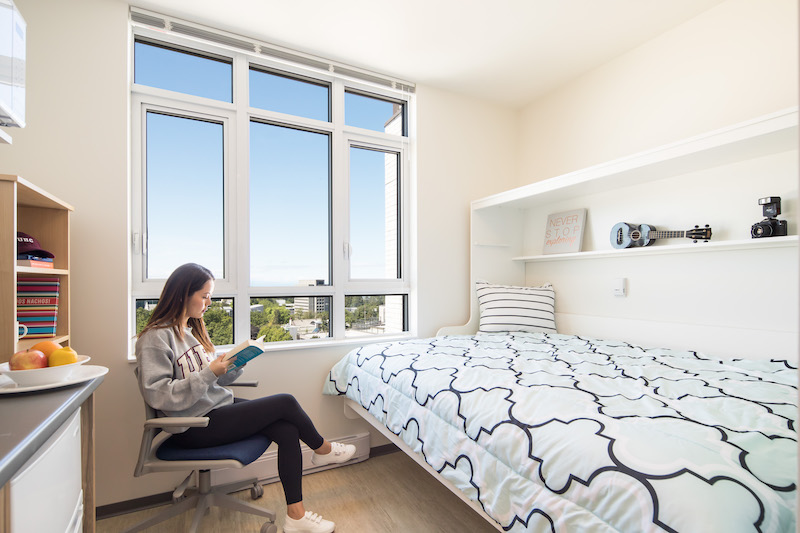 Nano suites at the University of British Columbia in Vancouver, designed by DIALOG.
Nano suites at the University of British Columbia in Vancouver, designed by DIALOG.
If single occupancy is a must, an attractive option for colleges and universities may be micro apartments. New or renovated, single occupancy, micro apartments could serve any student population in the short term (during a virus outbreak), but then be tuned specifically to upperclassmen and graduate students in the long term. There are popular examples of these in Seattle and at the University of British Columbia in Vancouver called “Nano Suites”. A very small studio apartment with a bathroom, furniture that converts from a desk to a bed, and a kitchenette that comes with a small fridge, two element stove, and sink, provides a condensed but affordable living option that can be paired with generous common space. Today, many upperclass and graduate students struggle to find affordable housing close to or on campus in part because of budget constraints, but also, because of the lack of university-owned, upperclass housing. Micro apartment units that offer the privacy and independence of single occupancy along with proximity to main campus, and the affordability of small footprints may have renewed relevance and interest in the COVID-19 era.
We acknowledge that student and staff behavior is perhaps the largest variable in residence hall virus protection. But with careful design strategies, we believe the residential environment can have a significant impact on virus resiliency in the short term and benefit students and the universities they call home in the long term. Thanks for reading and stay tuned for our next article in the Student Life Series.
Related Stories
| Aug 11, 2010
Dual physics buildings aim for LEED Silver
Two new physics buildings providing 197,000 sf of teaching, study, and office space are opening at Texas A&M University. The $82.5-million George P. Mitchell '40 Physics Building and the George P. and Cynthia Woods Mitchell Institute for Fundamental Physics and Astronomy offer new research laboratories, graduate and undergraduate lounges, offices, a 468-seat lecture hall, and a 180-seat aud...
| Aug 11, 2010
University building gets revamped, reused
KSS Architects of Philadelphia is designing the addition and renovation to SUNY Cortland's Studio West, a 43,000-sf metal panel and brick building dating to 1948. The 20,000-sf, two-story addition will become the Professional Studies Building, housing the consolidated departments of Recreation, Parks, and Leisure Studies; Communications Disorders and Sciences; and Kinesiology and Sports Managem...
| Aug 11, 2010
Project is music to school's ears
Florida Gulf Coast University is building a $7.55 million Fine Arts Building on its campus near Ft. Myers, Fla. The 25,000-sf building—the first project in the school's plan for an entire music complex—will house the music program of the College of Arts and Sciences. The facility includes a 200-seat recital hall, rehearsal hall, music labs, studio rooms, and administration offices.
| Aug 11, 2010
BU students move into high-rise dorm
Boston University’s newest residential building rises 26 stories above the Charles River. Part of the school’s 10-acre John Hancock Student Village, the 396,000-sf tower houses 962 students and has three apartments for faculty use. The tower also has a large multipurpose room on the top floor.
| Aug 11, 2010
Expansion of chemistry facility no experiment
A September ground breaking at Wayne State University in Detroit puts the school’s A. Paul Schaap Chemistry Building and Lecture Hall on track for a December 2010 completion. The $37 million, 96,000-sf facility is the second phase of a two-phase project to expand and renovate the existing chemistry building.
| Aug 11, 2010
Polshek unveils design for University of North Texas business building
New York City-based architect Polshek Partnership unveiled its design scheme for the $70 million Business Leadership Building at the University of North Texas in Denton. Designed to provide UNT’s 5,600-plus business majors with a state-of-the-art learning environment, the 180,000-sf facility will include an open atrium, an internet café, and numerous study and tutoring rooms—al...
| Aug 11, 2010
Cooper Union academic building designed to reach LEED Platinum
Morphosis Architects and Gruzen Samton are collaborating on an ultra-green academic building for New York’s Cooper Union that is designed to achieve LEED Platinum certification. The program for the nine-story facility mixes state-of-the-art laboratories, classrooms, a multipurpose auditorium, and a range of public and social spaces.
| Aug 11, 2010
Utah research facility reflects Native American architecture
A $130 million research facility is being built at University of Utah's Salt Lake City campus. The James L. Sorenson Molecular Biotechnology Building—a USTAR Innovation Center—is being designed by the Atlanta office of Lord Aeck & Sargent, in association with Salt-Lake City-based Architectural Nexus.
| Aug 11, 2010
Construction begins on Louisiana State Sports Hall of Fame
Heavy construction and foundation work has started on the new Louisiana State Sports Hall of Fame and Regional History Museum in Natchitoches, La. Designed by Trahan Architects, Baton Rouge, the $12 million, 28,000-sf museum will be clad in sinker cypress planks as a nod to the region’s rich timber legacy and to help control light, views, and ventilation throughout the facility.
| Aug 11, 2010
Modest recession for education construction
Construction spending for education expanded modestly but steadily through March, while at the same time growth for other institutional construction had stalled earlier in 2009. Education spending is now at or near the peak for this building cycle. The value of education starts is off 9% year-to-date compared to 2008.


